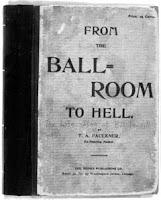Let's catch up with part one: leading up to and including the 1900s...
It would be impossible to do justice to the entire history of worldwide partnered dance in a single article, clearly! I have chosen European 'society' dances and American vernacular jazz dances. These eventually lead to rock n roll, jive and what many now know as 'swing dancing'; my area of expertise. There is still SO much to cover, so let's get stuck in!
Dances served - and still serve - a very important purpose in our communities. They provide a welcoming environment for people to meet, mingle and let off steam. During social dances throughout the ages there was sometimes close, if brief, contact with the opposite sex, and in 'proper’ society circles - til perhaps even World War Two - this was one of the few places one could (with some measure of freedom) interact with those outside ones direct family or household. We might call partner dancing the original 'speed dating'!
 |
| Thank you to |
 |
| By Anonymous - http://community.livejournal.com/retro_ladies/190520.html, Public Domain, |
The banjo was the most likely instrument to be seen on the plantations and enjoy continued popularity well into the twentieth century, though it was eventually eclipsed by the guitar. The European country dances would be accompanied by fiddle and bodhran (drum) at Ceilidhs. Waltzes were often written for piano and then played by string quartets at dances, with little or no percussive or ‘rhythm’ section added. Composers such as Franz Schubert composed many waltzes intended for purely social dancers - rather than virtuoso musical performances.
The new century is beginning and the Tower Ballroom has recently opened in Blackpool, England. Jazz and blues music continue to make their way across the USA via the musicians travelling from creative hubs like New Orleans and Memphis. Innovation in partner dance is underway whether it be in waltz, blues or what are to become known later as 'swing' dances. Tango hasn’t been exported from Argentina quite yet, but is gaining in momentum during this first decade of the twentieth century.
We might these days think of waltz as 'straight laced', given it has exact requirements regarding alignment, the placing of one's feet and the focus upon 'correctness'. Watch an episode of 'Strictly' and listen to the judges' critique of Viennese waltz and you will see what I mean! It has however, enjoyed sustained popularity for centuries, this author has her fingers crossed for the same happening with the swing styles!
 |
| "Vien Walz"--circa 1820s Hungarian print of salon waltzing photographed withowner's permission near the office door of the 300-year old Piaristenkellar |
Any ‘overtaking’ other couples should be executed with finesse!
By 1900s we know that 'slow drag' was being danced to the emerging blues music in Memphis and other musical cities. To picture slow drag, imagine alternating your weight from your left to your right foot, and back, feet hip width apart. Now take slightly larger steps side to side and as you step, allow your free foot to 'slow(ly) drag' across the floor towards the foot you've stepped onto (repeat at will). If you then stand with a partner, connect via holding hands and mirror each other, we now having the beginnings of one style of (partner) blues dance as it's known and still danced today.
 |
This image shows the Buddy Bolden Band in 1905
In England, James Finnigan (first President of the Manchester and Salford Association of Teachers of Dancing, founded in 1903) is credited with devising the military two step. You can view contemporary clips of dancers emulating military balls from many eras, (19)00s included, online. There you will see varying levels of authenticity in wardrobe options. Gentlemen were most often seen in tail coats at dances and it is pre World War One so fabric for women’s dresses isn’t restricted as yet. Surveying the dance floor you would have seen dresses with modest necklines, lamb chop sleeves, full length gloves, and, of course, full skirts to the floor (absolutely no ankles on show!)
As the century establishes itself, mass migration for better opportunities continues and cross pollination in both music and dance is one of the many wonderful results of this. Those of us enjoying jive, swing or ballroom today owe a great debt to the incorporation of African movement into the ballroom dances across turn of the century America. Swing and blues dance have enchanted me for 8 years, and I look forward to showing you why in the coming posts!
Velody helps you maximise your comfort and fun on the dance floor.
She curates many vintage dance events, including the Cotton City Blues festival:
*This article was originally printed in Vintage Life Magazine, October 2015. Most previous editions are now SOLD OUT so subscribe to this blog to get more dancing through the decades straight to your inbox!
No comments:
Post a Comment
Note: only a member of this blog may post a comment.